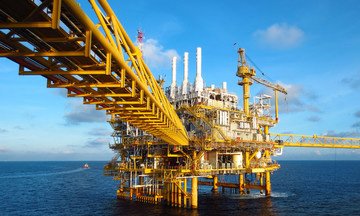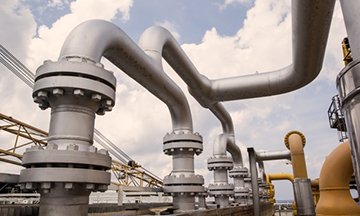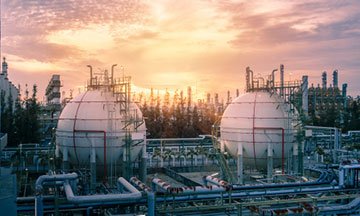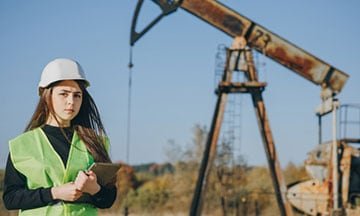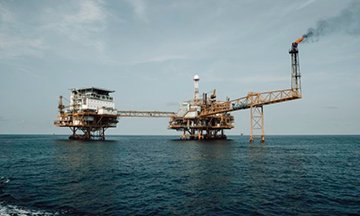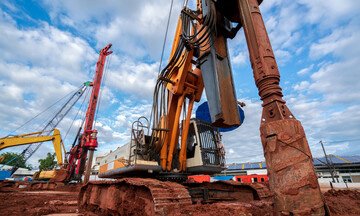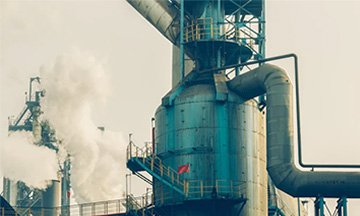Oil & Gas Marine Terminals: Operation, Management and Safety in accordance with International Standards
Course Overview
Oil & Gas Marine Terminals are important installations for importing (unloading) and exporting (loading) hydrocarbon raw materials and finished products respectively. The raw materials may be crude oil, gases, various types of hydrocarbon chemicals, intermediate petrochemicals, etc.
The finished hydrocarbon products may be petroleum & petrochemical products and derivative products of processed gas, numbering into hundreds. These incoming and outgoing oil & gas materials can be highly flammable, toxic, and corrosive, and hence they pose a lot of hazards.
Their safe handling and operational management must be done as per international standards. Incidents having Health, Safety, and Environment (HSE) outcomes or these potential implications are regularly seen in such terminals globally. Major incidents could be fire, explosion, toxic/lethal releases, collapsing of marine loading/unloading platforms & structures, ship collision, etc.
The oil & gas terminals traditionally have interconnected jetty and tank farm areas. Jetty has the loading arms which dock with the ship and thus form connections between the ship and the onshore tank farm for the purpose of receiving the raw materials (unloading) and/or sending out the finished products (loading). A number of operational, safety and management features are incorporated in such oil & gas marine terminals around which this training course is designed.
This Zoe training course will empower participants with the needed knowledge on Oil & Gas Marine Terminals: Operation, Management, and Safety in accordance with International Standards.
Course Objectives
This important and comprehensive Oil & Gas Marine Terminals Course will equip the participants to:
- Appreciate the basic layout of an Oil & Gas Marine Terminal
- Understand the operations and management of an Oil & Gas Marine Terminal
- Note the marine protocols for entry of ships into port channels, docking, and undocking
- Examine the review of documentation as per standard operating procedures
- Analyse the importance of shift crew briefing and seamless communication between the ship and the shore
- Perform Risk Assessment for loading and unloading operations
- Learn the Safety and Fire Protection features of an Oil & Gas Marine Terminal
- Importance of inspection and maintenance at the Oil & Gas Marine Terminals
- Study the operational/HSE incidents at various Oil & Gas Marine Terminals
- Train on the emergency response at the Terminal
- Learn the associated international standards
- Understand and address Insurance, Legal and Statutory Implications
Training Methodology
This collaborative ‘Oil & Gas Marine Terminals: Operation, Management, and Safety in accordance with International Standards’ program will comprise the following training methods:
- Lectures
- Seminars & Presentations
- Group Discussions
- Assignments
- Case Studies & Functional Exercises
Zoe Talent Solutions follows the ‘Do-Review-Learn-Apply’ model.
Organisational Benefits
Companies who nominate their employees to participate in this ‘Oil & Gas Marine Terminals: Operation, Management, and Safety in accordance with International Standards’ course can benefit in the following ways:
- Have a trained and confident workforce in operation and management of the marine oil & gas terminals
- Avoid HSE incidents such as fire and explosion which can risk the company’s business continuity
- This training will provide a positive impact on customers, lenders, insurance underwriters, management system certification agencies, regulatory & statutory authorities, industry and societal spectrum at large
Personal Benefits
Individuals who participate in this ‘Oil & Gas Marine Terminals: Operation, Management, and Safety in accordance with International Standards’ course can gain from it in the following ways:
- Development of confidence in operation, management, and safety of the marine oil & gas terminals
- Since marine terminals are high-risk specialized areas, such highly sought-after training courses enrich attendee’s professional profiles significantly
- Better ability to respond to emergencies so that personal and organizational safety is well protected
Who Should Attend?
This ‘Oil & Gas Marine Terminals: Operation, Management, and Safety in accordance with International Standards’ course would be ideal for:
- All marine-related line functions at all levels (trainees, interns, officers, managers, senior managers in operation, maintenance, inspection, engineering, other line disciplines)
- HSE Professionals at all levels (trainees, interns, technicians, officers, managers, and others)
- Middle management and Senior management (a smaller customized part of this course)
- Insurance, management system certification agencies, regulatory & statutory authorities
Course Outline
MODULE 1: BASIC LAYOUT OF AN OIL & GAS MARINE TERMINAL
- Jetty: loading platform, loading arms, berthing and mooring dolphins, connecting bridges
- Piping, slop oil vessels, motorized valves
- Access trestles
- Gangways
- Access Roads
- Tank farm
- Boil-off Flares
- Port/Port infrastructure
MODULE 2: MARINE PROTOCOLS
- Marine Terminal Port Regulation
- Entry of Ships into Port Channels, Docking, and Undocking
- Roles of tugs as Escorts in and Escorts out
- Ship and berth compatibility/Draught limitation
- Communication channels
- Documentation controls for loading and unloading
- Standard Operating Procedures
- Port Security & Safety
- Port control tower/Control room
- Incident Reporting
- Mutual Aid
MODULE 3: RISK ASSESSMENT FOR LOADING AND UNLOADING OPERATION
- Flammability, explosivity, toxicity, and corrosivity of materials being handled
- Weather conditions/wind nautical speed
- Tidal positions
- Port congestion
- Mooring
- Existing spillage of hydrocarbon liquids on the water surface
- Language barriers between the ship and the shore crews
- Operational and safety readiness
- Stoppage of Hot Work and Control of ignition
MODULE 4: OPERATIONS AND MANAGEMENT OF AN OIL & GAS MARINE TERMINAL
- Terminal Manager
- Loading and Unloading Shift Manager
- Operation shift crew
- Maintenance shift crew
- Fire & Safety shift crew
- Cargo System Gauges and Alarms
- Loading/Unloading briefing
- Approval of data and operations as per SOPs
- Communication between the ship and the shore
- Coordination with the Port control tower
- Safety precautions
MODULE 5: SAFETY AND FIRE PROTECTION FEATURES OF THE JETTY AND THE TANK FARM
- Fixed Fire & Gas Detectors
- Fire Water Hydrant networks with hoses
- Fire water spray/deluge systems for identified tanks and vessels
- Fire water curtain between the ship and the jetty
- Tower Monitors for Fire Water and Foam system
- Portable Fire extinguishers
- Emergency Manual Alarm points
- Fire proofing
- Self-contained Breathing Apparatus Stations
- Online Breathing Apparatus Stations
- Safety Showers and Eye washes
MODULE 6: IMPORTANCE OF INSPECTION AND MAINTENANCE
- Asset Integrity management strategy
- Deterioration monitoring
- Data analysis and reporting of high-risk scenarios to terminal management
- Inspection of safety critical equipment/items such as:
- Loading Arm’s Emergency Release Coupling (ERC)
- Pressure relief valves
- Drain connections
- Contents gauge
- Service valves
- Filling connections
- Hydrostatic valves
- Emergency shut-down valves
- Pressure gauges
- Temperature gauges
- Lightning protection
- Fire protection and safety equipment
MODULE 7: STUDY OF OPERATIONAL/HSE INCIDENTS AND EMERGENCY RESPONSE
- Loading Arm’s Emergency Release Coupling (ERC)/ Powered ERC
- Study/Review the global incidents on marine terminals
- Root causes of incidents and brainstorming the ways to stop recurrence
- Attendees’ participation in solution proposals
MODULE 8: ASSOCIATED INTERNATIONAL MARINE STANDARDS AND BEST PRACTICES
- Regional Organization for the Protection of the Marine Environment (ROPME)
- International Maritime Organization (IMO) guidelines and rules
- Environmental, Health, and Safety Guidelines Ports, Harbours, and Terminals (World Bank Group)
- OHSA (USA), Health & Safety Executive (HSE UK), International Labour Organization (ILO), and other international guidelines
MODULE 9: INSURANCE, AUDIT, LEGAL AND STATUTORY IMPLICATIONS
- Oil & Gas Terminal as third-party focus grabber
- Terminals as huge stakes and risk avenues
- Insurance premiums are high



